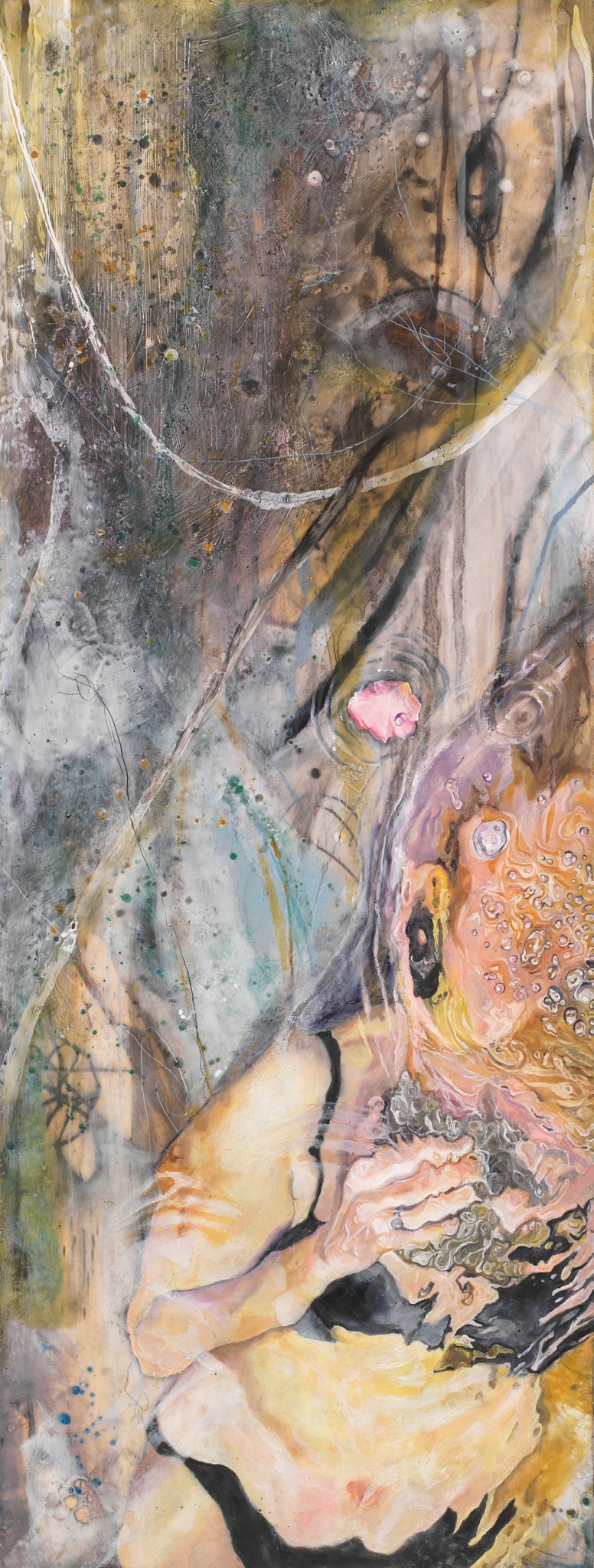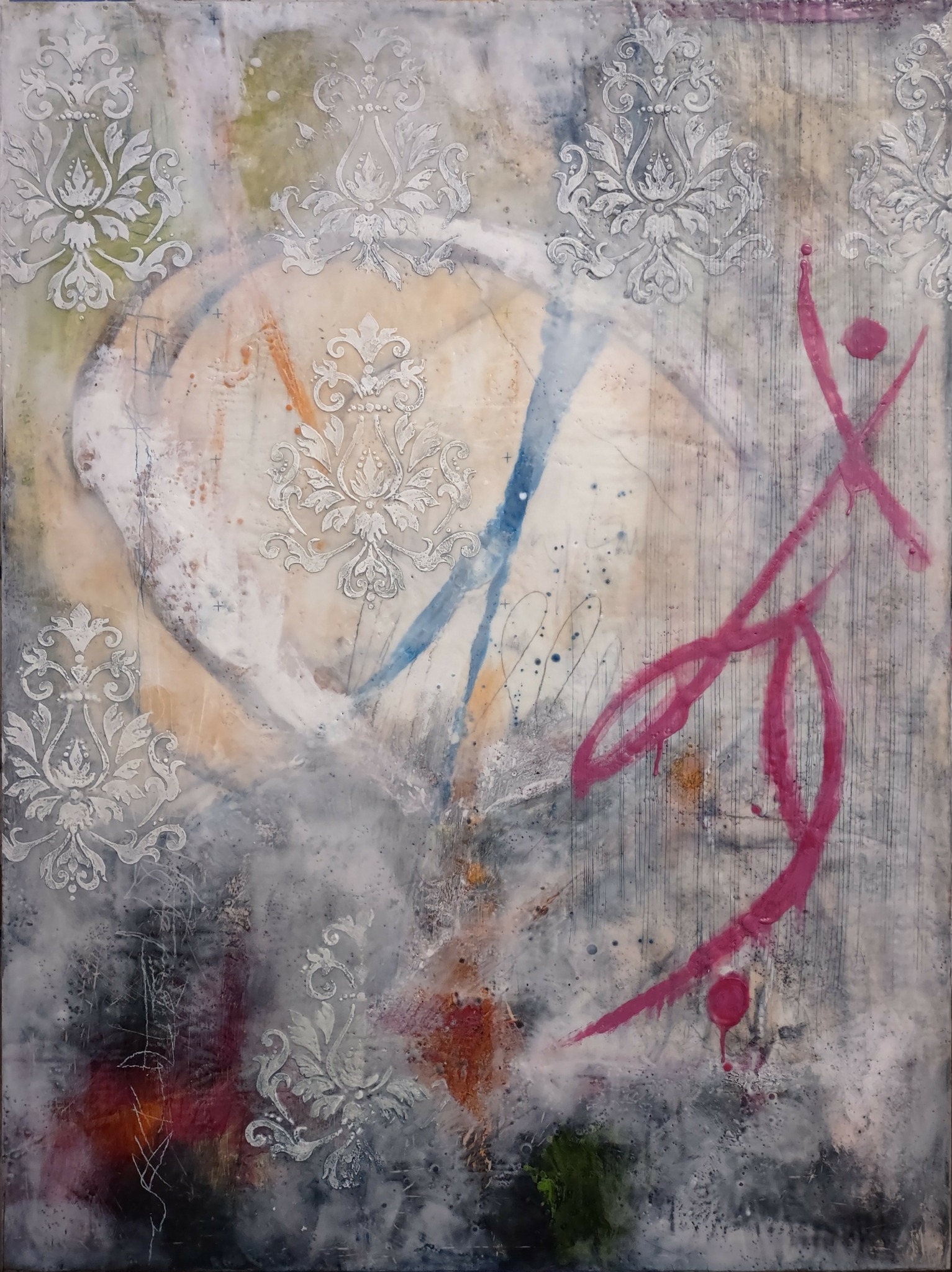We were lucky to catch up with Kate Santucci recently and have shared our conversation below.
Kate, thanks for joining us, excited to have you contributing your stories and insights. What’s been the most meaningful project you’ve worked on?
I recently had a solo show called Water Rising. The pieces were all centered on water images, both abstracted and realistic. My medium is encaustic, which is a mixture of beeswax, damar resin, and pigment. It is applied in layers and fused with a torch. The layers are built up, and can be used to create visual depth and texture. When I originally began thinking about the body of work, I wanted to push my medium to really capture the feel of water, the depth and reflections in water, and the layers and translucency that the medium could bring into the depiction of water. I was thinking about climate change, flooding, and our relationship to water on a large scale, and how we adapt – or don’t- to environmental change. In the several years that I worked on the series, my perspective began to shift. The work got much more personal. I lost my father in law and brother in law 2 weeks apart, I had some health issues for the first time in my life, and my father was diagnosed with ALS. I was doing a lot of care-taking, grieving, and juggling my roles in life. I felt like I was barely able to keep my head above water in any of my roles- artist, mother, partner, daughter, sister, and friend. The pieces became more turbulent, and the figurative elements addressed floating, drowning, and being completely submerged. The story of Ophelia really resonated with me, and I understood the desire to wade into the water and let go. I added flower petals floating on the surface of the water to pull the viewer into that personal narrative, and connect to the intimate story of whether or not we’re staying afloat on both a personal scale, and in the greater sense of our rapidly changing environment.


Great, appreciate you sharing that with us. Before we ask you to share more of your insights, can you take a moment to introduce yourself and how you got to where you are today to our readers.
I am an artist living and working in Dayton, Ohio. I work primarily with encaustic medium, and that has been my focus for over 10 years. My background is in sculpture and theatrical costuming. I started school in costume design, and then transferred to the art department after realizing that what I loved about theater was more about the unseen creative process and rendering images, and less about the actual work of live theater. I worked as a costumer for the ballet and as an art teacher before stepping away to raise my children. During that time I was making small works, and things I could complete outside of a dedicated studio space. In 2014 I attended a 3 day encaustic workshop. I really didn’t know much about the medium at all when I went- I just needed a creative vacation. I absolutely fell in love with it, and when I got home I dove in head first. My kids were teenagers by then, and I was ready to focus on my own work. I set up a studio in my attic and began making small encaustic paintings, experimenting, reading and watching tutorials, and learning the medium. I had my first show in 2015. I moved out of my attic and into a larger studio space in 2019, and that really changed the direction of my work. It allowed me to paint on a much bigger scale. I was able to create large public works that were purchased by our library system to hang in one of their new buildings. I began showing regularly around the Dayton area, and I started teaching workshops in encaustic painting.
Encaustic is not a well known medium, and the opportunity to talk to people about it, explain the process and the history, and pass on the techniques has allowed me to grow in my own practice, as well as teach others. Encaustic is a combination of beeswax, damar tree resin, and pigments. It is applied to a wood substrate in layers, each layer being fused to the one below it with a torch. The technique allows for the creation of great depth. You can build up textures, scrape back layers to reveal colors and images under the surface, carve into it, or melt it into a glassy smooth surface. It is compatible with oil based paints, graphite, charcoal, pastels, and inks. It can be used as a collage medium, or applied as a finish in sculptural works. It is definitely process oriented, and I find that process endlessly fascinating. The details and possibilities of encaustic are what I love so much about working with the medium.
My current paintings involve using writing to set an intention and direction for the work. I use illegible script, mark making, and asemic writing as part of an under painting created with charcoal, graphite, walnut ink, and encaustic medium. The work combines both abstract mark making and figurative realism to help convey my thoughts on how we interpret meaning and context in our struggle to understand one another, our world, and our role in it. The paintings have multiple layers and textures, inviting the viewer to look deeper into the piece and glimpse imagery floating beneath the surface of the wax, while allowing the top most layers of encaustic paints and pigment stick to come forward and engage the viewer in the narrative.


We’d love to hear a story of resilience from your journey.
At the end of 2022 I had just lost 2 family members in rapid succession, and was a week and a half away from a solo show opening when I got a call from my studio mate that the boiler in our 150 year old building had stopped working, and our space had been without heat for several days over Christmas. No one had notified us. It was brutally cold out, and when I walked into the studio, it was 17 degrees inside. Encaustic is susceptible to extreme temperature changes. When it freezes, the wax contracts and it can send cracks throughout the painting. After I finished panicking and assessed all the paintings- literally my entire catalogue of work- I found I had 29 damaged paintings. Nearly all of the damage was in work that was not being hung the next week. Total stroke of luck. I was able to successfully repair the couple of paintings that required it, and got my show up. I think my takeaway from the whole experience is how important it is to have a community you can call on when things get rough, and you have something wholly unexpected happen. I had a group of friends come and help me finish framing and packing work for the show while I made repairs. The support of friends and fellow artists is essential, and maintaining those relationships is so important. Making art can be a very solitary pursuit, and we can lose track of the people we need in our lives if we’re not intentional about those relationships. That experience made me really examine what I wanted, and why I felt driven to keep making my work. In the moment, I was really close to walking away. I didn’t have a lot of margin at that point, and it felt like a last straw. I ended up plowing on. That spring I continued to repair pieces, and I moved into a new studio. I was able to begin a new series that I showed almost exactly two years later.


What do you find most rewarding about being a creative?
There is an inherent risk in “putting yourself out there” as an artist. We all understand that art is very subjective, and what draws the attention of one viewer may be completely uninteresting to someone else. We remind ourselves of that with every submission rejection, and every time we are passed over, because it is true. At the same time, each rejection feels painful and personal, because what is also true is that we are pouring a little bit of ourselves into our works, and when someone is judging the work, they are also judging a part of us. That can be a lot to hold, especially when we have a piece that we’ve spent countless hours on and are genuinely proud of, and it’s not garnering attention. So, for me, one the most rewarding things that can happen is when someone comes through my studio at an art hop and stops and spends time with a piece. It’s the conversations that happen when someone just really gets it, and understands what I was saying without my explaining it. I’m happy to talk about my work, my inspirations, and my thoughts leading into the creation of the piece. But those moments when I don’t have to, and the viewer tells me what they’re getting from the work, and that matches exactly what I was feeling- those moments are gold. It’s when I feel most seen by another person. I am always thrilled when I sell a painting, but it’s the interaction and moment of being seen and understood that are the most rewarding.
Contact Info:
- Website: https://www.katehusersantucci.com/
- Instagram: katesantucciart
- Facebook: Artwork of Kate Huser Santucci
- Linkedin: Kate Santucci


Image Credits
Joe VanDehatert
Kate Santucci


